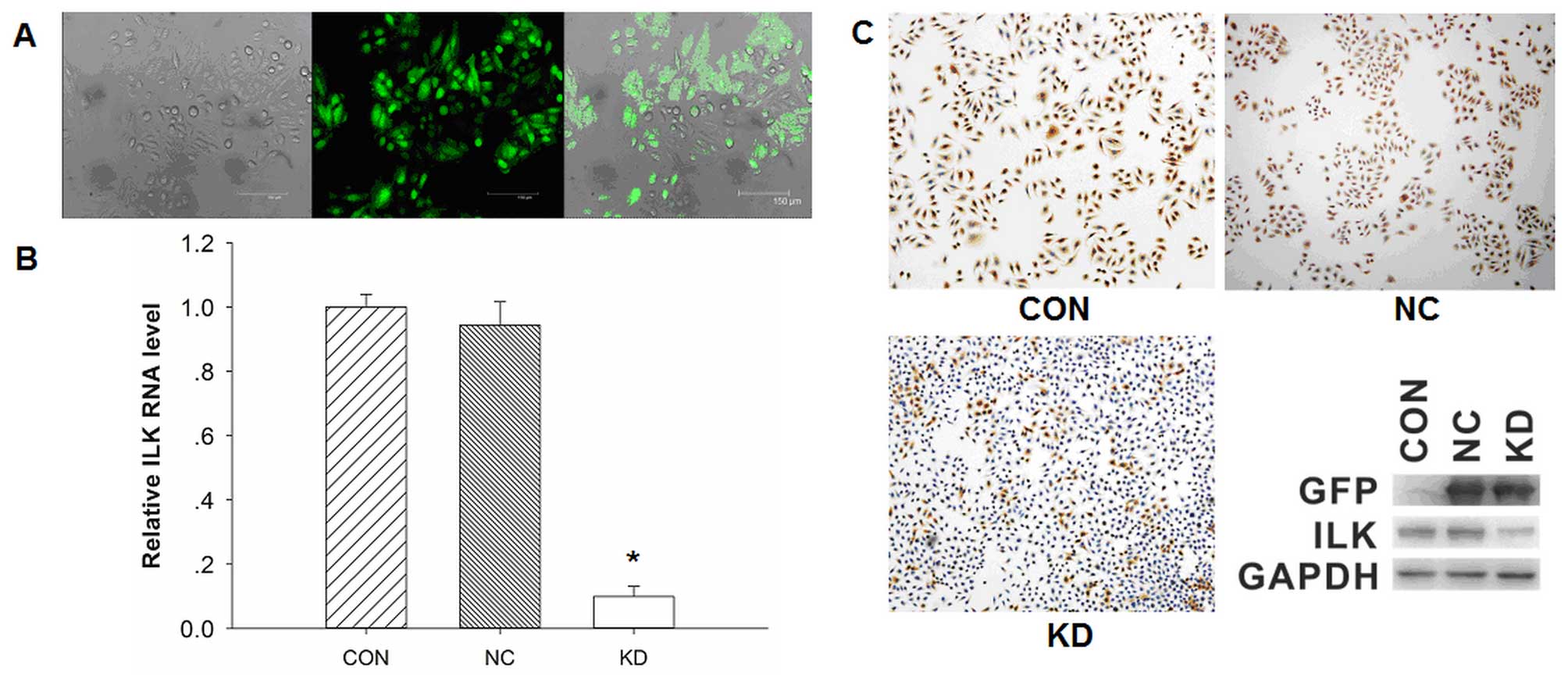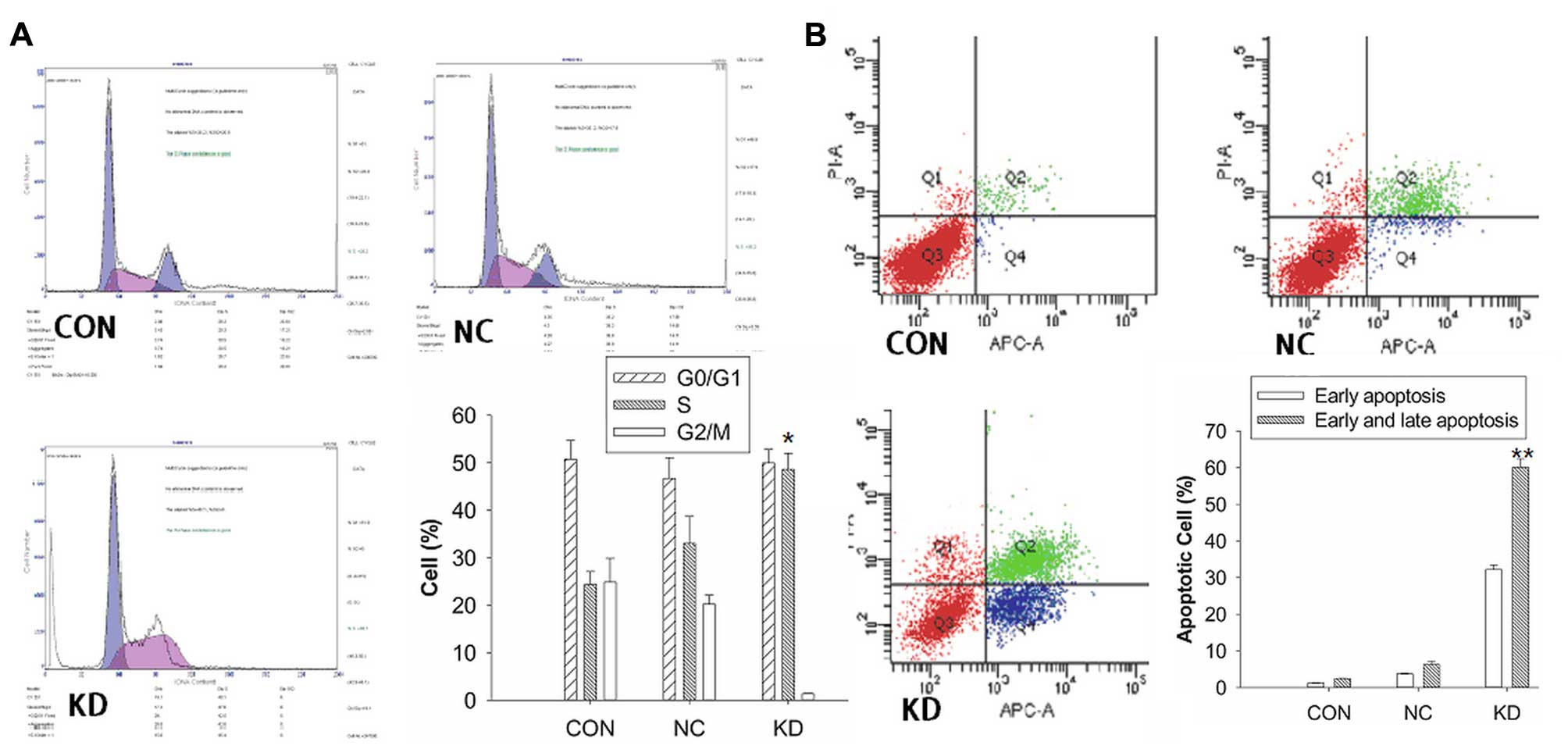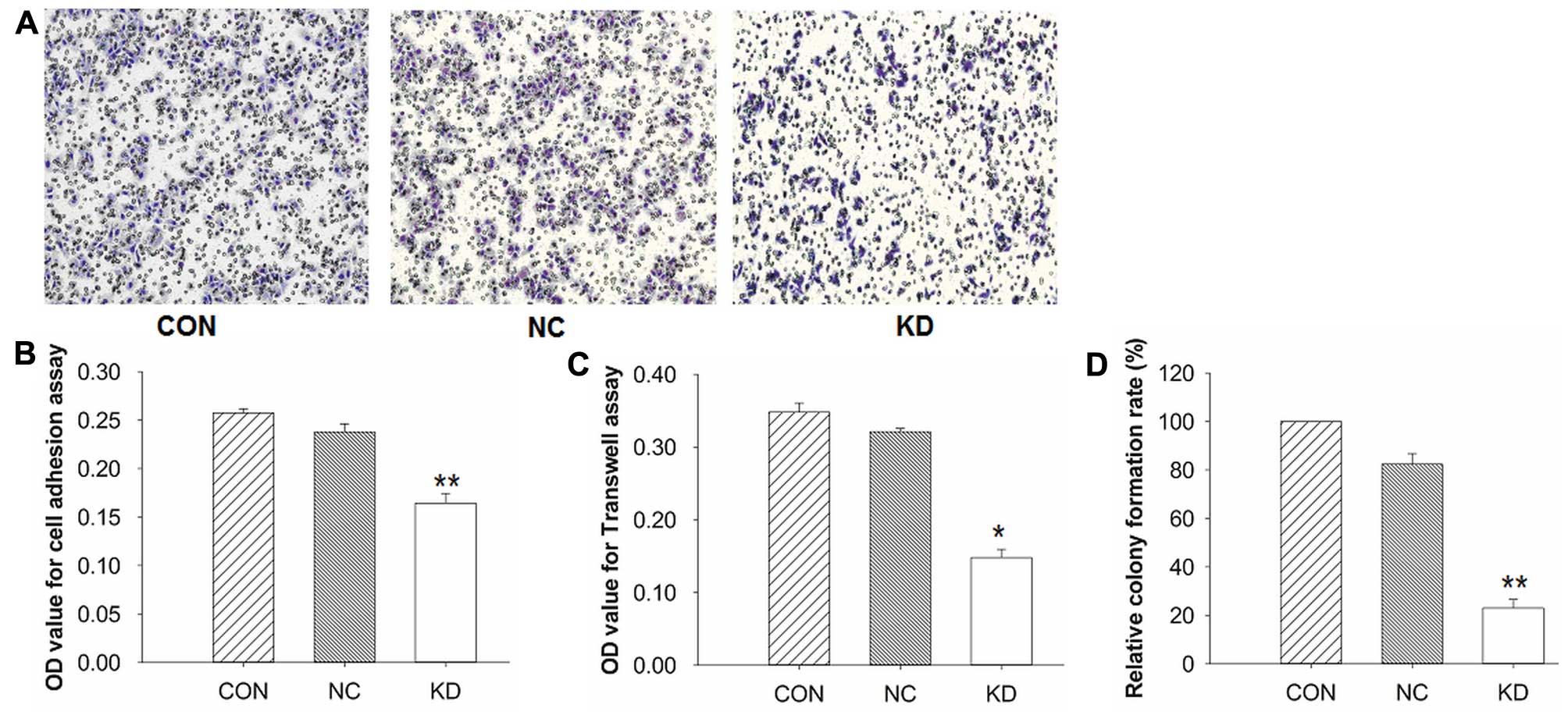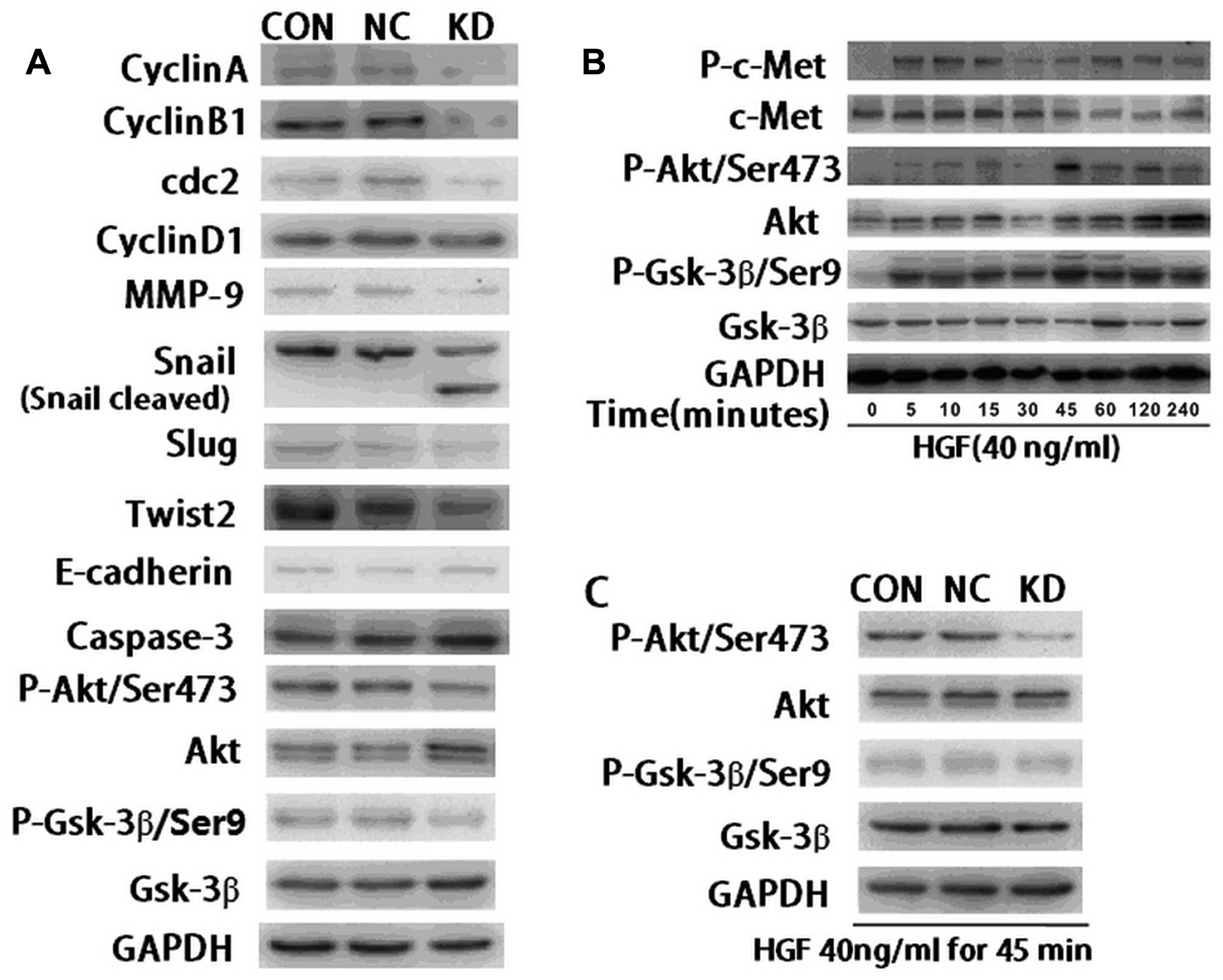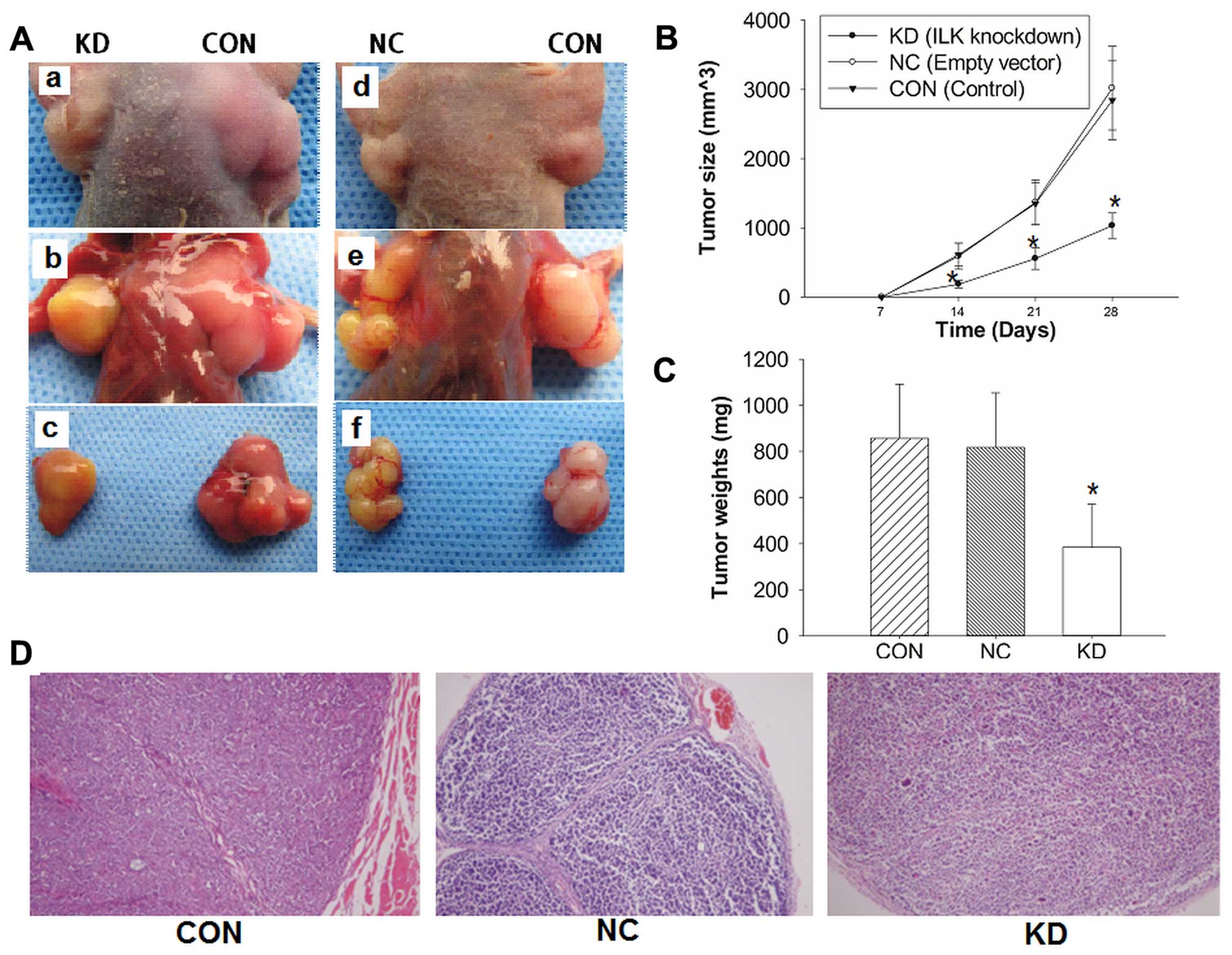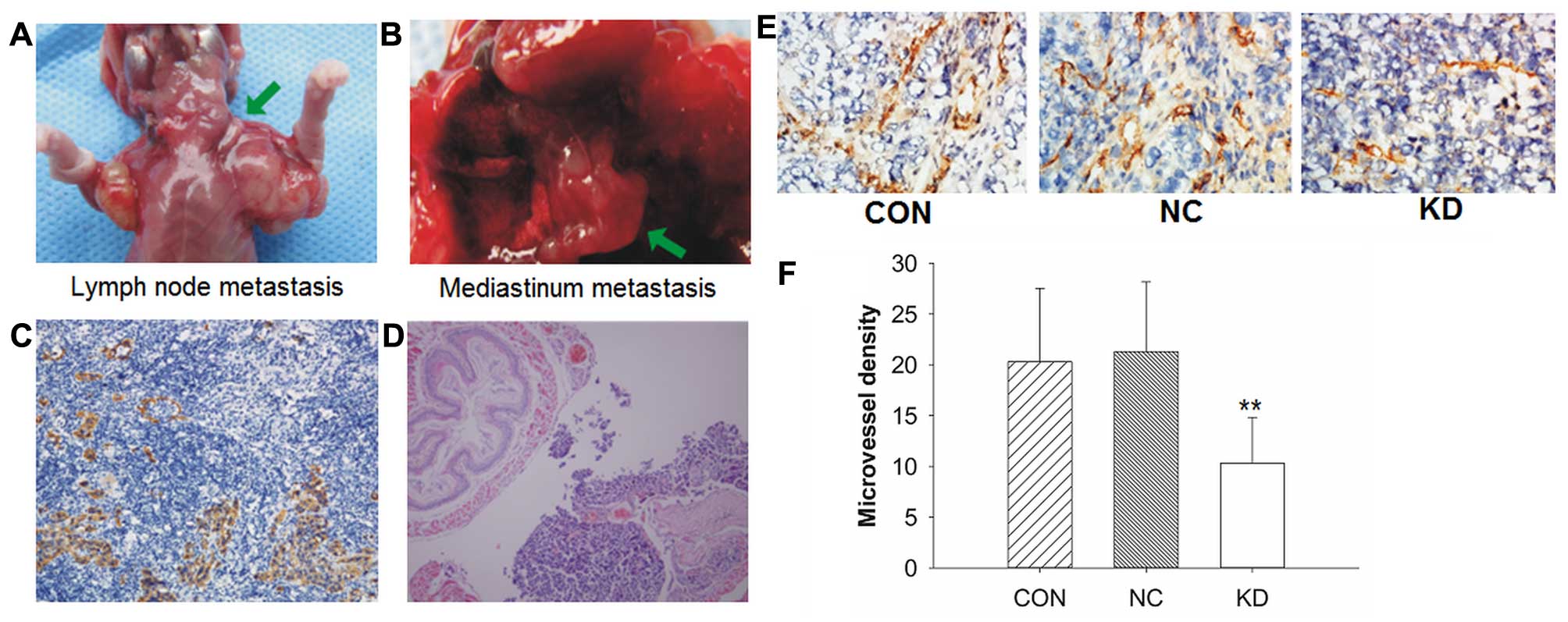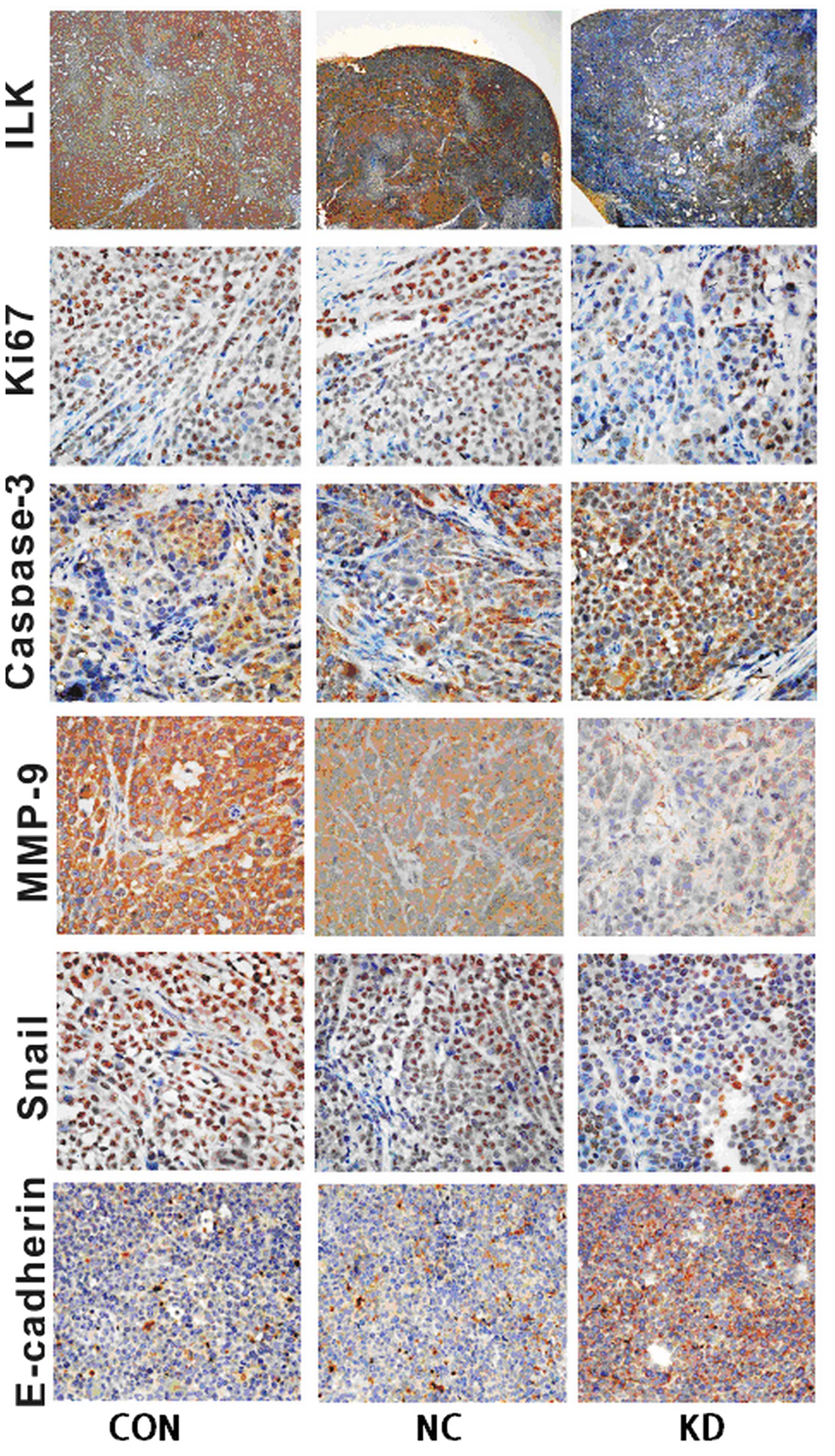Effects of lentivirus-mediated shRNA targeting integrin-linked kinase on oral squamous cell carcinoma in vitro and in vivo
- Authors:
- Published online on: November 2, 2015 https://doi.org/10.3892/or.2015.4374
- Pages: 89-98
Abstract
Introduction
Oral squamous cell carcinoma (OSCC) is a common malignancy in the oral cavity, accounting for ~90% of all oral tumors, with an estimated 300,000 new cases annually (1). Despite advances in diagnosis and multimodal therapies, tumors are associated with a poor prognosis with patient 5-year survival rates of approximately 50%. The unfavorable prognosis is mainly caused by local invasion and the earlier regional lymph node metastasis that impedes complete tumor resection and leads to inevitable postoperative recurrence (2). Therefore, understanding the underlying molecular mechanisms involved in the progression of OSCC and developing a novel therapeutic strategy is imperative.
Integrin-linked kinase (ILK), a ubiquitously expressed protein with serine/threonine protein kinase activities, interacts with cytoplasmic domains of β1 and β3 integrins (3,4). As a multifunctional adaptor protein, ILK has been regarded as a vital regulator of the phosphoinositide 3-kinase (PI3K) signaling pathway, which activates protein kinase B (PKB)/Akt activity and inhibits glycogen synthase kinase-3 (Gsk-3) activity, regulating cell proliferation, apoptosis, differentiation, migration, invasion, angiogenesis and epithelial-mesenchymal transition (EMT) (5,6). EMT is a complex cell process in which cells lose their epithelial features and acquire a mesenchymal phenotype, which plays a vital role in embryogenesis, tissue remodeling, wound healing and tumor metastasis. EMT process is associated with the reduced expression of epithelial markers such as E-cadherin, and increased expression of mesenchymal markers such as C-cadherin (7–9). Overexpression of ILK has been reported in various types of cancer (10–13), promoting cell migration and invasion by inducing EMT (12,14–17). Consistent with the abovementioned findings, our previous study on OSCC clinical specimens revealed that ILK facilitated the progression and metastasis of OSCC through the EMT-related upregulation of Snail and consequent aberrant expression of E- and N-cadherin (18). Knockdown of ILK has been reported to inhibit cell proliferation, migration, invasion, angiogenesis, and promotes apoptosis in different types of cancer cells, including gastric cancer, bladder cancer, lung cancer, ovarian carcinoma, and tongue cancer (19–23). However, the molecular mechanisms by which ILK contributes to the development and progression of OSCC via EMT remain to be investigated.
In the present study, a lentivirus-mediated short hairpin RNA (shRNA) targeting ILK was generated and the effects of ILK silencing on OSCC cells were investigated. The results revealed that the knockdown of ILK inhibited cell proliferation, invasion, blocked the cell cycle, promoted cell apoptosis and suppressed the EMT process in vitro by regulating the Akt and GSk-3β signaling pathways. Knockdown of ILK also suppressed tumor growth, invasion and metastasis in nude mice xenograft models. In summary, the results indicated that ILK is imperative in the development and progression of OSCC and has the potential to be an efficient therapeutic target for OSCC treatment.
Materials and methods
Cell line and culture
The human OSCC BCaCD885 cell line was obtained from the State Key Laboratory of Oral Diseases, Sichuan University (Chengdu, China) and cultured in Dulbecco's modified Eagle's medium (DMEM; Gibco-Life Technologies, Grand Island, NY, USA) supplemented with 15% fetal bovine serum (FBS; Hyclone, Logan, UT, USA), 1% penicillin/streptomycin at 37°C in a humidified atmosphere with 5% CO2. The cells were routinely passaged every 2–3 days by trypsinization (Gibco-Life Technologies). The cells at the logarithmic growth phase were used in the present study.
Construction of lentiviral vectors expressing ILK-specific shRNA and transfection (24,25)
The ILK-specific target sequence was selected according to online siRNA tools utilized from Invitrogen (http://www.invitrogen.com/rnai) and the GenBank (accession no. NM 004517.2). Double-stranded DNA containing the interference sequences were synthesized according to the manufacturer's instructions (sequence: 5′-CGA AGC TCA ACG AGA ATC A-3′) (GeneChem, Shanghai, China), and the negative control shRNA targeted a random and non-specific sequence with no homology to the human genome. The sequences were cloned into the pGCSIL-green fluorescent protein (GFP; GeneChem) to generate the lentiviral vectors, and then transfected into BCaCD885 cells. On the day of infection, the culture medium was replaced with the appropriately titered viral supernatant and incubated at 37°C for 12 h. After 3 days of transfection, the number of GFP-positive cells was measured, and shRNA ILK-silencing efficiency was determined using western blotting. The titers were averaged to 8×109 TU/ml. The lentivirus containing the human ILK shRNA-expressing cassette was used as a positive control and designated as the KD group. The empty vector was used as a negative control, designated as the NC group, and the non-transfected as the CON group.
RNA isolation and quantitative PCR
Total RNA was prepared using TRIzol reagent (Invitrogen-Life Technologies, Carlsbad, CA, USA) and cDNA was synthesized using the PrimeScript® RT reagent kit (Takara, Dalian, China). ILK mRNA expression was evaluated quantitatively by RT-qPCR with SYBR® Premix Ex Taq™ (Takara) and the ABI PRISM 7900HT Real-Time PCR system (ABI, Vernon, CA, USA). The primers were synthesized (Sangon, China) and the sequences used were: ILK forward, 5′-ATG GAA CCC TGA ACA AAC ACT-3′ and reverse, 5′-AGC ACA TTT GGA TGC GAG AAA-3′; and GAPDH forward, 5′-GCT GTC CCT GTA CGC CTC TG-3′ and reverse, 5′-TGC CGA TGG TGA TGA CCT GG-3′. GAPDH served as an internal control. The thermocycler conditions used were: preheating at 95°C for 30 sec, 95°C for 5 min, 30 cycles of 10 sec at 95°C, 20 sec at 60°C, 30 sec at 72°C. The relative amount of PCR product was evaluated as the comparative threshold cycle of the sample divided by that of GAPDH (2−ΔΔCt) (26). Experiments were carried out in triplicate and repeated three times.
Protein extraction and western blot analysis
The cells were washed with ice-cold PBS twice and treated with cell lysis buffer (50 mmol/l Tris, pH 7.8, 150 mmol/l NaCl, 1% Nonidet-40), then centrifuged at 175 × g for 10 min, and the supernatants were collected and stored at −80°C. Protein concentration was measured using the bicinchoninic acid assay (BCA Protein Assay kit; Thermo Fisher Scientific lnc., Rockford, IL USA). Equal amounts (50 µg) of protein were heated at 95°C for 5 min, separated by 8–12% SDS-PAGE gel, and electrotransferred onto polyvinylidene fluoride (PVDF) membranes (Bio-Rad, Hercules, CA, USA). The PVDF membranes were then blocked with 5% skim milk in Tris-buffered saline and incubated overnight at 4°C with monoclonal primary rabbit antibody of anti-human ILK, cyclin A, cyclin B1, cyclin D1, CD31, Snail (Cell Signaling Technology, Danvers, MA, USA), Akt, p-Akt (Ser473), Gsk-3β and p-Gsk-3β (Ser9) (Bioworld Technology, St. Louis Park, MN, USA), E-cadherin, Slug, Twist2 and polyclonal primary mouse antibody of anti-human caspase-3, MMP-9 (1:1,000 dilution; Beijing Zhongshan Biotechnology, Beijing, China) and washed four times with PBS-T. Subsequently, the membranes were incubated with HRP-conjugated secondary antibodies of goat anti-rabbit or goat anti-mouse IgG (1:1,000 dilution) at room temperature for 1 h and washed four times with PBS-T. The signal was then visualized with an enhanced chemiluminescence assay according to the manufacturer's instructions (LumiGLO Peroxidase Chemiluminescent Substrate kit; KPL, Gaithersburg, MD, USA). The amounts of proteins were quantified by densitometry and GAPDH of the same sample served as an internal control.
Colony formation assay
The effect of ILK silencing on the colony formation of BCaCD885 cells was analyzed using the colony formation assay. Approximately 3×102 cells were plated in 60-mm dishes and cultured in 10% FBS DMEM at 37°C, 5% CO2 for 2 weeks. The cell colonies were washed twice with PBS, fixed with methanol for 5 min and stained with crystal violet for 20 min, and then washed twice using ddH2O. A colony was defined as aggregates consisting of ≥50 cells, and manually counted under a microscope (Leica DM LB2, Wetzlar, Germany). The experiments were performed in triplicate and repeated three times.
Cell cycle analysis
BCaCD885 cells were collected and washed with ice-cold PBS, fixed with 70% ethanol for 24 h, then centrifuged at 600 × g for 5 min, and resuspended in propidium iodide (PI; Sigma, St. Louis, MO, USA) supplemented with RNase A and incubated at 37°C in the dark for 30 min, then analyzed using a flow cytometer (Beckman Coulter, Brea, CA, USA) to measure the cell cycle distribution. The relative proportions of the cells in the individual cell-cycle phase fraction were determined from the flow cytometry data. The experiments were performed in triplicate and repeated three times.
Cell apoptosis analysis
After the cells were harvested, 5×105 cells were rinsed twice with PBS, and centrifuged at 600 × g for 5 min and resuspended in 500 µl binding buffer. The cells were then incubated for 15 min with 1 µl of Annexin V-PE and 5 µl 7-AAD for 15 min at room temperature in the dark according to the manufacturer's instructions (Annexin V-PE/7-AAD Apoptosis Detection kit; Keygentec, China). Cell apoptosis was analyzed using flow cytometry (Beckman Coulter). The experiments were carried out in triplicate and repeated three times.
Transwell invasion assay
After reaching 80% confluence, the BCaCD885 cells were digested with 0.05% trypsin and resus-pended at 5×104 cells/100 µl. Prior to cell incubation, the cells (300 µl) and 200 µl of serum-free DMEM were added to the in the inner chamber, and DMEM medium (500 µl) with 10% FBS to the lower chamber, between which the Matrigel gel (BD Biosciences, Billerica, MA, USA) was placed on the surface of the filtration membrane of the Transwell micropore with an aperture of 8 µm. Following incubation at 37°C for 24 h, the non-invading cells in the inner chamber and the extracellular Matrigel were gently removed and washed with PBS. The number of invasive cells that migrated through the gel to the lower surface of the membrane were stained with 1% crystal violet for 20 min and images were captured under a phase contrast microscope in five random fields. Results were presented as the mean percentage of the control (control OD at 562 nm assigned as 100%). Each experiment was performed in triplicate and repeated three times.
Cell adhesion assays
Prior to cell cultivation, 50 µl of extracellular matrix gel (ECM gel; Sigma) mixed with serum-free DMEM (1:1) and 50 µl serum-free DMEM containing 10 g/l bovine serum albumin (BSA; Sigma) were added to 96-well plates and incubated at 37°C for 30 min. BCaCD885 cells were trypsinized and resuspended at 5×104 cells/100 µl in DMEM medium. Cells (100 µl) were added to the 96-well plate and cultured for 4 h. After incubation, the non-adherent cells were removed by PBS washing, and adherent cells were fixed and stained with 1% crystal violet for 20 min at 37°C. Absorbances at 590 nm were determined using a microplate reader (Bio-Rad).
Animals and tumor xenograft treatment model
Fifteen 6-week-old BALB/C-nu/nu mice were purchased from Sichuan University Experimental Animal Center (Sichuan, China), bred and held under specific pathogen-free conditions. The mice were allowed access to food and water ad libitum prior to surgery under optimal conditions (12-h light/dark with humidity at 60±5%, 22±3°C). The protocol was approved by the Ethics Committee of the State Key Laboratory of Oral Diseases, Sichuan University. Animal procedures were performed according to the internationally accepted ethical guidelines.
Single-cell suspension of 100 µl containing 2×106 BCaCD885 cells was injected subcutaneously into the skin of the two armpits for each mouse. When tumors formed on day 7 after inoculation, the mice were randomly divided into three treatment groups, n=5 mice per group. Different treatments were performed on the three groups over four consecutive days. For group 1, one side was injected with 1×107 TU (50 µl) lentivirus-encoded shRNA targeting ILK (KD) and the other side was injected with 50 µl sterilizing saline (CON). Mice in group 2 were injected on one side with KD and the other side with 1×107 TU (50 µl) negative control lentivirus (empty vector, NC). Mice in group 3 were injected on one side with NC and the other side with CON. The time of tumor formation was recorded, and 28 days after injection, the mice were sacrificed. The xenograft tumors were excised and weighed, fixed in 10% buffered formalin at room temperature for pathology analysis, and the other tumor tissues were immediately placed in liquid nitrogen for the frozen section of immunofluorescence assay.
Histology and immunohistochemistry
The tumor tissue, lymph node and vital organs harvested from mice xenograft were fixed in 10% buffered formalin and embedded in paraffin, and 5-µm sections were stained with hematoxylin and eosin. The microvessels were counted from 10 different fields under the microscope at a magnification of ×200, corresponding to areas with the highest density of vessels.
After being fixed and embedded, the samples were dewaxed twice in xylene for 15 min and rehydrated in gradient concentration of ethanol (approximately 10–15 ml) at room temperature. The sections were treated with 3% hydrogen peroxide for 30 min at room temperature and rinsed three times with PBS to block non-specific antibodies. The samples were incubated in primary antibodies of rabbit anti-human ILK (1:100 dilution; Cell Signaling Technology), Snail (1:200 dilution) and E-cadherin (1:100 dilution) (both from Abcam, Cambridge, MA, USA), caspase-3 (1:100 dilution), Ki67 (1:100 dilution) and MMP-9 (1:100 dilution) (Beijing Zhongshan Biotechnology) separately at 37°C for 60 min and incubated overnight at 4°C. The sections were subsequently washed three times with PBS, and incubated in secondary antibodies for 40 min at 37°C using DAB staining (DAB Horseradish Peroxidase Color Development kit; Beijing Zhongshan Biotechnology). The sections were then counterstained with hematoxylin, dehydrated and mounted. To detect tumor angiogenesis, the sections were incubated in the monoclonal primary mouse anti-human CD31 (1:100 dilution; BD Biosciences) overnight at 4°C, and the remainder of the procedure was performed as mentioned above. Observations were performed under an Olympus multifunction microscope (Olympus, Tokyo, Japan) and fluorescence microscope (Leica DM LB2). Each section was examined independently by two pathologists and five fields of view were randomly selected under an optical microscope at magnification of ×200.
Statistical analysis
Data were presented as the means ± SD. Differences between groups were analyzed by one-way ANOVA. Statistical analysis was performed using the SPSS 13.0 software package (SPSS Inc., Chicago, IL, USA). P<0.05 was considered to indicate statistical significance.
Results
Observation of transfection efficiency and identification of ILK expression
The transfection efficiency was determined under a fluorescence microscope. A large number of cells exhibited bright green fluorescence, which represented high transfection efficiency, while no green fluorescence was detected in non-transfected cells (Fig. 1A). The transfected cells were isolated by G418 selection, and then cultured and identified using qPCR, western blotting and an immuno-fluorescence assay. The mRNA expression of ILK was significantly downregulated in BCaCD885 ILK knockdown cells (KD group) compared with the BCaCD885 vector cells (NC group) and BCaCD885 cells (CON group), and the results were statistically significant (P<0.05, Fig. 1B). By contrast, there was no significant difference on ILK mRNA expression between CON and NC cells.
Immunofluorescence images showed that ILK was significantly weaker in KD cells compared with the control cells (Fig. 1C). The protein expression of ILK was significantly reduced by 80.0% in the KD cells compared with the NC cells.
Effects of ILK knockdown on cell cycle and cell apoptosis
The cell cycle profile was analyzed by flow cytometry (Fig. 2A). The data revealed that the percentage of KD cells blocked in the S phase (48.67±3.36%) was significantly higher compared with the CON cells (24.36±2.75%) and NC cells (33.03±5.86%), respectively (P<0.05, Fig. 2B). The results suggested that the knockdown of BCaCD885 ILK cells were arrested at the restriction point of the cell cycle and failed to enter mitosis, leading to cell apoptosis.
The cell apoptotic rate was evaluated by flow cytometry. As shown in Fig. 2B, the results showed that the early apoptotic cells (APC+, PI−, 32.2%) and late apoptotic cells (APC+, PI+, 27.9%) in the KD group were significantly higher than the control groups (P<0.01), which indicated that the inhibition of cell proliferation may be caused by apoptotic cell death.
Knockdown of ILK suppressed cell adhesion, invasion and cell proliferation of BCaCD885 cells
We examined the effects of ILK silencing on the cell adhesion and invasion of BCaCD885 cells. The cell adhesion assay showed that the number of KD cells adhering to the extracellular cell matrix gel was markedly decreased compared to the remaining groups (P<0.01), and there was no significant difference between the NC and CON groups (P>0.05, Fig. 3B). Furthermore, to determine the effect of ILK knockdown on cell invasion ability, a Transwell assay was applied. As shown in Fig. 3A, the cells cultured in Transwell chambers were allowed to migrate through the 8-µm pores of membranes coated with Matrigel. The penetrating cells in the KD group were fewer than those in the control groups (P<0.05, Fig. 3C), which was consistent with the adhesion assays. These results demonstrated that the knockdown of ILK suppressed the abilities of adhesion and invasion of BCaCD885 cells.
The colony formation assay was applied for the detection of cell proliferation, and the results showed that the KD cells had a significantly lower cell proliferation rate than the remaining cells (P<0.01). However, no significant difference was observed between the NC and CON groups (P>0.05, Fig. 3D).
Effects of downregulating ILK on the expression of proteins associated with cell proliferation, invasion, apoptosis and EMT
To determine the underlying mechanism of downregulating ILK on cell proliferation, invasion, apoptosis and EMT, western blot analysis was applied to detect the expression of the corresponding proteins. Images showed that the expression of cyclin A, cyclin B1 and cdc2, key proteins regulating the cell cycle from S phase to G2/M phase, were significantly down-regulated in KD cells compared with the control cells (Fig. 4A). The expression of cyclin D1, which was involved in regulating the cell cycle from G1 to S phase, was only slightly down-regulated (Fig. 4A). Fig. 4A also showed that the expression of MMP-9, which refers to the ability of cell invasion, was inhibited in ILK knockdown cells compared with the control cells. Notably, the expression of key regulating proteins of EMT, including Snail, Twist2 and Slug, were also reduced in KD cells. A protein band of cleaved Snail was observed in ILK knockdown cells (Fig. 4A). At the same time, the expression of E-cadherin was slightly upregulated in the KD cells. An increase of caspase-3 protein was detected in KD cells, indicating that ILK may promote cell apoptosis by upregulating caspase-3. The findings suggested that downregulating ILK suppressed EMT and the invasiveness of OSCC cells.
Effects of ILK knockdown on the expression of downstream signaling target molecules
To examine the ILK downstream targets and molecular mechanisms of the effects that ILK knockdown exerted on BCaCD885 cells as mentioned above, we investigated the protein levels of Akt, Gsk-3β and their phosphorylated formation. Western blot analysis showed that expression of p-Akt (Ser473) and p-Gsk-3β (Ser9) were inhibited in ILK knockdown cells compared with the control cells (Fig. A). However, the expression of Akt and Gsk-3β showed no difference in the three groups (Fig. 4A).
To determine the effects of ILK knockdown on the phosphorylation of Akt and Gsk-3β induced by exogenous growth factors, we used hepatocyte growth factor (HGF) as an intervention, which was capable of activating PI3K and was present in the tumor microenvironment. The phosphorylation levels of Akt and Gsk-3β were detected by western blot analysis. The results showed that 5 min after BCaCD885 cells were treated with HGF at 40 ng/ml, c-Met, the phosphorylation of HGF receptor was observed. After 45 min, the phosphorylation level of Akt and Gsk-3β reached its peak (Fig. 4B). The phosphorylation level of Akt and Gsk-3β in ILK knockdown cells was not as significant as in the control cells. These results suggested that ILK was able to inhibit HGF-induced Akt and Gsk-3β phosphorylation to a certain extent (Fig. 4C).
Knockdown of ILK inhibits tumor growth and metastasis of BALB/C nude mouse xenograft model
To investigate whether ILK shRNA inhibited the growth of tumors in a nude mouse xenograft model, 2×106 cells in 0.1 ml PBS were implanted subcutaneously into the armpits of BALB/C nude mice. The growth of mouse xenograft tumors was significantly inhibited in the KD group compared with the control groups (Fig. 5A). Mice were sacrificed and the tumors were collected and stained with H&E (magnification, ×100) and immunohistochemistry (Fig. 5D). The average tumor sizes were 1,032±182 mm3 in the KD group, 3,021±606 mm3 in the NC group and 2,835±571 mm3 in the CON group (Fig. 5B), and the average tumor weights were 302±188 mg in the KD group, 817±237 mg in the NC group and 857±235 mg in the CON group (Fig. 5C). The inhibiting rate of tumor growth was 55.56 or 53.57%, respectively. Statistical analysis revealed significant differences between the KD group and the remaining groups (P<0.05).
Mice from the KD group also showed a significant inhibition of the spontaneous lymph node or distant metastasis, in which no metastasis was observed, whereas lymph node metastasis (Fig. 6A) was detected in 2/10 of the mice injected with negative control lentivirus and in 3/10 of the mice injected sterilizing saline. One case of mediastinum metastasis (Fig. 6B) was detected in the CON group. Fig. 6C and D show the representative images of immunohistochemical staining of cytokeratin and H&E sections (magnification, ×100).
Immunohistochemical staining of CD31 was applied to detect the correlation between new blood vessel formation and tumor growth. Data revealed that the KD group showed a low CD31 expression and apparent inhibition of angiogenesis in the tumor tissue, while intense CD31 expression and a higher number of vessels were observed in the control groups (Fig. 6E). The KD group showed less vessels compared with the control groups (P<0.01, Fig. 6F).
Immunohistochemical assays were performed to confirm ILK expression and its impact on some of its downstream signaling target molecules associated with EMT in xenograft tumors (Fig. 7). The results indicated that the KD group had an apparent decreased expression of ILK, Ki67, MMP-9, Snail as well as a higher caspase-3 and E-cadherin expression in tumor tissue, compared with the control groups (Fig. 7). The results were in concordance with assays in vitro and supported the suggestion that the knockdown of ILK suppressed OSCC tumor growth, metastasis and EMT in vitro and in vivo.
Discussion
OSCC is a lethal epithelial cancer occurring in the oral cavity. The disease is associated with a poor prognosis resulting from its local invasion and early regional lymph node meta stases (27). Previously, by analyzing OSCC clinical specimens, we revealed that ILK overexpression was associated with the progression and metastasis of OSCC, possibly through EMT-related upregulation of Snail and the consequent aberrant expression of E- and N-cadherin (15). The underlying mechanisms of invasion and metastasis of OSCC remain to be elucidated, although previous findings have (28) demonstrated that EMT may be of great importance.
ILK is a widely expressed multifunctional intracellular effector of cell-matrix interactions that play a vital role in the regulation of numerous cell processes including EMT. EMT or EMT-like phenomena are considered a prerequisite for metastasis, in certain cases (29). The functional loss of E-cadherin and presence of N-cadherin are regarded as characteristics of the EMT program (30). The downregulation of E-cadherin, an epithelial cell marker and a potent suppressor of tumor cell invasion and metastasis, is mediated through several repressors, such as Snail, Slug and Twist (31).
In the present study, we have demonstrated that the knockdown of ILK inhibited the EMT process with increased E-cadherin expression and decreased N-cadherin expression in vitro and in vivo, which is the hallmark of EMT (30). Transcriptional repression is a major mechanisms leading to the downregulation of E-cadherin, which is suppressed by repressors such as Snail, Slug, Twist, ZEB1 and vimentin (32,33). Our findings showed that the knockdown of ILK inhibited EMT-associated transcription factors such as Snail, Slug and Twist2, as well as MMP-9 expression in vitro and in vivo. We also demonstrated that downregulation of ILK inhibited cell proliferation, adhesion and invasion, arrested the cell cycle, and promoted cell apoptosis in vitro. Radeva et al (34) reported that ILK signaling pathways increased the expression of cyclin D1, activation of cyclin-dependent kinase 4 and cyclin E-associated kinases, promoting the cell cycle from the G1 to the S phase. Inhibition of ILK induced cell cycle arrest at the G1 phase (35,36). However, the results showed that the percentage of KD cells blocked in the S phase (48.67±3.36%) was significantly higher, as compared with the control groups, suggesting the cell cycle was arrested at the restriction point and failed to enter mitosis, leading to cell apoptosis. Cell apoptosis analysis revealed that the early apoptotic cells (APC+, PI−, 32.2%) and late apoptotic cells (APC+, PI+, 27.9%) in the KD group were significantly increased compared with the control groups. Western blotting images demonstrated that the protein expression of cyclin A, cyclin B1 and Cdc2, key proteins regulating cell cycle from the S phase to G2/M phase, decreased significantly, while the cyclin D1 protein expression slightly inhibited the KD group. Studies by Fielding et al (37–39) indicated that, ILK played a critical and unexpected role in the organization of centrosomal protein complexes during mitotic spindle assembly and DNA segregation. Thus, the knockdown of ILK resulted in mitosis failure and the cell cycle was arrested at the S phase. These findings suggest that downregulation of ILK suppressed the development and progression of OSCC cells.
Furthermore, the knockdown of ILK inhibited the phosphorylation of its downstream targets Akt on Ser473 and Gsk-3β on Ser9, respectively, and Gsk-3β downregulated Snail phosphorylation on Ser246. The knockdown of ILK inhibited the phosphorylation of Akt, and inhibited Akt activity (40). Thus, ILK and Akt phosphorylation deactivated Gsk-3β, and subsequently inhibited Snail phosphorylation, leading to EMT (41). Kalra et al (42) reported that the knockdown of ILK suppressed p-Akt, p-Gsk-3β, β-catenin, Snail, MMP-9 and Twist. We have demonstrated that the knockdown of ILK inhibited p-Akt and p-Gsk-3β although no significant changes were identified in Akt and Gsk-3β expression. The results also supported the above findings, indicating that ILK plays a vital role in the EMT process through the Akt/Gsk-3β/Snail pathway, which was in agreement with the previous study (23). To investigate the effects of the ILK knockdown on the p-Akt and p-Gsk-3β induced by exogenous growth factors, HGF was applied prior to detection, which existed in the tumor micro-environment and activated PI3K. The results revealed that ILK was able to inhibit HGF-induced Akt and Gsk-3β phosphorylation to a certain extent.
In addition, the animal experiment showed that the knockdown of ILK significantly inhibited the tumor growth in xenograft models, with tumor inhibition rates of 55.56 or 53.57%, respectively. ILK knockdown also suppressed spontaneous lymph node or distant metastasis in vivo. Compared with the control groups, the KD group exhibited lower micro vascular density, which is necessary for tumor growth and metastasis. Cell proliferation and prevention of necrosis requires that tumor growth be dependent on adequate oxygen and nutrients, as induced by tumor angiogenesis (43). Immunohistochemical images of xenograft tumor tissue confirmed that ILK knockdown suppressed OSCC tumor growth, metastasis and EMT.
In conclusion, the findings of the present study have demonstrated that the knockdown of ILK inhibited the proliferation and metastasis of OSCC cells in vitro and in vivo. The present results suggest that ILK is crucial in cell progression, metastasis and EMT, by regulating key proteins such as Akt, Gsk-3β, MMP-9, Snail, E-cadherin and caspase-3, which were essential for cell proliferation, apoptosis, metastasis, angio-genesis as well as EMT. Thus, ILK should be regarded as a newly proven oral cancer metastasis regulator and a potential therapeutic molecular target for OSCC.
Acknowledgments
This study was supported by grants from the Sichuan Science Foundation (contract grant nos. 2011SZ0156 and 2014SZ0204) and the National Natural Science Foundation of China (contract grant no. 81202134).
References
|
Scully C and Felix DH: Oral medicine - update for the dental practitioner oral cancer. Br Dent J. 200:13–17. 2006. View Article : Google Scholar : PubMed/NCBI | |
|
Bello IO, Soini Y and Salo T: Prognostic evaluation of oral tongue cancer: Means, markers and perspectives (II). Oral Oncol. 46:636–643. 2010. View Article : Google Scholar : PubMed/NCBI | |
|
Hannigan GE, Leung-Hagesteijn C, Fitz-Gibbon L, Coppolino MG, Radeva G, Filmus J, Bell JC and Dedhar S: Regulation of cell adhesion and anchorage-dependent growth by a new beta 1-integrin-linked protein kinase. Nature. 379:91–96. 1996. View Article : Google Scholar : PubMed/NCBI | |
|
Zervas CG, Psarra E, Williams V, Solomon E, Vakaloglou KM and Brown NH: A central multifunctional role of integrin-linked kinase at muscle attachment sites. J Cell Sci. 124:1316–1327. 2011. View Article : Google Scholar : PubMed/NCBI | |
|
Hannigan G, Troussard AA and Dedhar S: Integrin-linked kinase: A cancer therapeutic target unique among its ILK. Nat Rev Cancer. 5:51–63. 2005. View Article : Google Scholar : PubMed/NCBI | |
|
Somasiri A, Howarth A, Goswami D, Dedhar S and Roskelley CD: Overexpression of the integrin-linked kinase mesenchymally transforms mammary epithelial cells. J Cell Sci. 114:1125–1136. 2001.PubMed/NCBI | |
|
Wu C, Keightley SY, Leung-Hagesteijn C, Radeva G, Coppolino M, Goicoechea S, McDonald JA and Dedhar S: Integrin-linked protein kinase regulates fibronectin matrix assembly, E-cadherin expression, and tumorigenicity. J Biol Chem. 273:528–536. 1998. View Article : Google Scholar : PubMed/NCBI | |
|
Nawshad A, Lagamba D, Polad A and Hay ED: Transforming growth factor-β signaling during epithelial-mesenchymal transformation: Implications for embryogenesis and tumor metastasis. Cells Tissues Organs. 179:11–23. 2005. View Article : Google Scholar | |
|
Foroni C, Broggini M, Generali D and Damia G: Epithelial-mesenchymal transition and breast cancer: Role, molecular mechanisms and clinical impact. Cancer Treat Rev. 38:689–697. 2012. View Article : Google Scholar | |
|
Li R, Liu B, Yin H, Sun W, Yin J and Su Q: Overexpression of integrin-linked kinase (ILK) is associated with tumor progression and an unfavorable prognosis in patients with colorectal cancer. J Mol Histol. 44:183–189. 2013. View Article : Google Scholar | |
|
Li J, Yang ZL, Ren X, Zou Q, Yuan Y, Liang L, Chen M and Chen S: ILK and PRDX1 are prognostic markers in squamous cell/adenosquamous carcinomas and adenocarcinoma of gallbladder. Tumour Biol. 34:359–368. 2013. View Article : Google Scholar | |
|
Chen D, Zhang Y, Zhang X, Li J, Han B, Liu S, Wang L, Ling Y, Mao S and Wang X: Overexpression of integrin-linked kinase correlates with malignant phenotype in non-small cell lung cancer and promotes lung cancer cell invasion and migration via regulating epithelial-mesenchymal transition (EMT)-related genes. Acta Histochem. 115:128–136. 2013. View Article : Google Scholar | |
|
Watzka SB, Setinek U, Stubenberger EB, Tötsch M, Dekan G, Marcher M, Fleck T and Müller MR: Integrin-linked kinase, phosphorylated AKT and the prognosis of malignant pleural mesothelioma. Eur J Cardiothorac Surg. 39:180–184. 2011. View Article : Google Scholar | |
|
Serrano I, McDonald PC, Lock FE and Dedhar S: Role of the integrin-linked kinase (ILK)/Rictor complex in TGFβ-1-induced epithelial-mesenchymal transition (EMT). Oncogene. 32:50–60. 2013. View Article : Google Scholar | |
|
Becker-Santos DD, Guo Y, Ghaffari M, Vickers ED, Lehman M, Altamirano-Dimas M, Oloumi A, Furukawa J, Sharma M, Wang Y, et al: Integrin-linked kinase as a target for ERG-mediated invasive properties in prostate cancer models. Carcinogenesis. 33:2558–2567. 2012. View Article : Google Scholar : PubMed/NCBI | |
|
Yan Z, Yin H, Wang R, Wu D, Sun W, Liu B and Su Q: Overexpression of integrin-linked kinase (ILK) promotes migration and invasion of colorectal cancer cells by inducing epithelial-mesenchymal transition via NF-κB signaling. Acta Histochem. 116:527–533. 2014. View Article : Google Scholar | |
|
Liang F, Zhang S, Wang B, Qiu J and Wang Y: Overexpression of integrin-linked kinase (ILK) promotes glioma cell invasion and migration and down-regulates E-cadherin via the NF-κB pathway. J Mol Histol. 45:141–151. 2014. View Article : Google Scholar | |
|
Zhao D, Tang XF, Yang K, Liu JY and Ma XR: Over-expression of integrin-linked kinase correlates with aberrant expression of Snail, E-cadherin and N-cadherin in oral squamous cell carcinoma: Implications in tumor progression and metastasis. Clin Exp Metastasis. 29:957–969. 2012. View Article : Google Scholar : PubMed/NCBI | |
|
Zhao G, Guo LL, Xu JY, Yang H, Huang MX and Xiao G: Integrin-linked kinase in gastric cancer cell attachment, invasion and tumor growth. World J Gastroenterol. 17:3487–3496. 2011. View Article : Google Scholar : PubMed/NCBI | |
|
Gao J, Zhu J, Li HY, Pan XY, Jiang R and Chen JX: Small interfering RNA targeting integrin-linked kinase inhibited the growth and induced apoptosis in human bladder cancer cells. Int J Biochem Cell Biol. 43:1294–1304. 2011. View Article : Google Scholar : PubMed/NCBI | |
|
Liu Q, Xiao L, Yuan D, Shi X and Li P: Silencing of the inte-grin-linked kinase gene induces the apoptosis in ovarian carcinoma. J Recept Signal Transduct Res. 32:120–127. 2012. View Article : Google Scholar : PubMed/NCBI | |
|
Guo X, Wang W, Hu J, Feng K, Pan Y, Zhang L and Feng Y: Lentivirus-mediated RNAi knockdown of NUPR1 inhibits human nonsmall cell lung cancer growth in vitro and in vivo. Anat Rec (Hoboken). 295:2114–2121. 2012. View Article : Google Scholar | |
|
Xing Y, Qi J, Deng S, Wang C, Zhang L and Chen J: Small interfering RNA targeting ILK inhibits metastasis in human tongue cancer cells through repression of epithelial-to-mesenchymal transition. Exp Cell Res. 319:2058–2072. 2013. View Article : Google Scholar : PubMed/NCBI | |
|
Federico Maurizio: Lentivirus Gene Engineering Protocols (Methods in Molecular Biology). Humana Press; 229. pp. 69–85. 2003 | |
|
Zheng YP, Liu H, Zeng H, Xiong L, Feng ZH and Sun NX: Downregulation of lentivirus-mediated ILK RNAi on tractional force generation in human retinal Müller cells. Acta Pharmacol Sin. 30:1625–1633. 2009. View Article : Google Scholar : PubMed/NCBI | |
|
Leong DT, Gupta A, Bai HF, Wan G, Yoong LF, Too HP, Chew FT and Hutmacher DW: Absolute quantification of gene expression in biomaterials research using real-time PCR. Biomaterials. 28:203–210. 2007. View Article : Google Scholar | |
|
Choi S and Myers JN: Molecular pathogenesis of oral squamous cell carcinoma: Implications for therapy. J Dent Res. 87:14–32. 2008. View Article : Google Scholar | |
|
Qiao B, Johnson NW and Gao J: Epithelial-mesenchymal transition in oral squamous cell carcinoma triggered by transforming growth factor-β1 is Snail family-dependent and correlates with matrix metalloproteinase-2 and -9 expressions. Int J Oncol. 37:663–668. 2010.PubMed/NCBI | |
|
Voulgari A and Pintzas A: Epithelial-mesenchymal transition in cancer metastasis: Mechanisms, markers and strategies to overcome drug resistance in the clinic. Biochim Biophys Acta. 1796:75–90. 2009.PubMed/NCBI | |
|
Araki K, Shimura T, Suzuki H, Tsutsumi S, Wada W, Yajima T, Kobayahi T, Kubo N and Kuwano H: E/N-cadherin switch mediates cancer progression via TGF-β-induced epithelial-to-mesenchymal transition in extrahepatic cholangio-carcinoma. Br J Cancer. 105:1885–1893. 2011. View Article : Google Scholar : PubMed/NCBI | |
|
Shin SY, Rath O, Zebisch A, Choo SM, Kolch W and Cho KH: Functional roles of multiple feedback loops in extracellular signal-regulated kinase and Wnt signaling pathways that regulate epithelial-mesenchymal transition. Cancer Res. 70:6715–6724. 2010. View Article : Google Scholar : PubMed/NCBI | |
|
Peinado H, Portillo F and Cano A: Transcriptional regulation of cadherins during development and carcinogenesis. Int J Dev Biol. 48:365–375. 2004. View Article : Google Scholar : PubMed/NCBI | |
|
Peinado H, Olmeda D and Cano A: Snail, Zeb and bHLH factors in tumour progression: An alliance against the epithelial phenotype? Nat Rev Cancer. 7:415–428. 2007. View Article : Google Scholar : PubMed/NCBI | |
|
Radeva G, Petrocelli T, Behrend E, Leung-Hagesteijn C, Filmus J, Slingerland J and Dedhar S: Overexpression of the integrin-linked kinase promotes anchorage-independent cell cycle progression. J Biol Chem. 272:13937–13944. 1997. View Article : Google Scholar : PubMed/NCBI | |
|
Persad S, Attwell S, Gray V, Delcommenne M, Troussard A, Sanghera J and Dedhar S: Inhibition of integrin-linked kinase (ILK) suppresses activation of protein kinase B/Akt and induces cell cycle arrest and apoptosis of PTEN-mutant prostate cancer cells. Proc Natl Acad Sci USA. 97:3207–3212. 2000. View Article : Google Scholar : PubMed/NCBI | |
|
D'Amico M, Hulit J, Amanatullah DF, Zafonte BT, Albanese C, Bouzahzah B, Fu M, Augenlicht LH, Donehower LA, Takemaru K, et al: The integrin-linked kinase regulates the cyclin D1 gene through glycogen synthase kinase 3beta and cAMP-responsive element-binding protein-dependent pathways. J Biol Chem. 275:32649–32657. 2000. View Article : Google Scholar : PubMed/NCBI | |
|
Fielding AB, Dobreva I, McDonald PC, Foster LJ and Dedhar S: Integrin-linked kinase localizes to the centrosome and regulates mitotic spindle organization. J Cell Biol. 180:681–689. 2008. View Article : Google Scholar : PubMed/NCBI | |
|
Fielding AB, Lim S, Montgomery K, Dobreva I and Dedhar S: A critical role of integrin-linked kinase, ch-TOG and TACC3 in centrosome clustering in cancer cells. Oncogene. 30:521–534. 2011. View Article : Google Scholar | |
|
Fielding AB and Dedhar S: The mitotic functions of integrin-linked kinase. Cancer Metastasis Rev. 28:99–111. 2009. View Article : Google Scholar : PubMed/NCBI | |
|
Koul D, Shen R, Bergh S, Lu Y, de Groot JF, Liu TJ, Mills GB and Yung WK: Targeting integrin-linked kinase inhibits Akt signaling pathways and decreases tumor progression of human glioblastoma. Mol Cancer Ther. 4:1681–1688. 2005. View Article : Google Scholar : PubMed/NCBI | |
|
Doble BW and Woodgett JR: Role of glycogen synthase kinase-3 in cell fate and epithelial-mesenchymal transitions. Cells Tissues Organs. 185:73–84. 2007. View Article : Google Scholar : PubMed/NCBI | |
|
Kalra J, Sutherland BW, Stratford AL, Dragowska W, Gelmon KA, Dedhar S, Dunn SE and Bally MB: Suppression of Her2/neu expression through ILK inhibition is regulated by a pathway involving TWIST and YB-1. Oncogene. 29:6343–6356. 2010. View Article : Google Scholar : PubMed/NCBI | |
|
Muramatsu M, Yamamoto S, Osawa T and Shibuya M: Vascular endothelial growth factor receptor-1 signaling promotes mobilization of macrophage lineage cells from bone marrow and stimulates solid tumor growth. Cancer Res. 70:8211–8221. 2010. View Article : Google Scholar : PubMed/NCBI |



